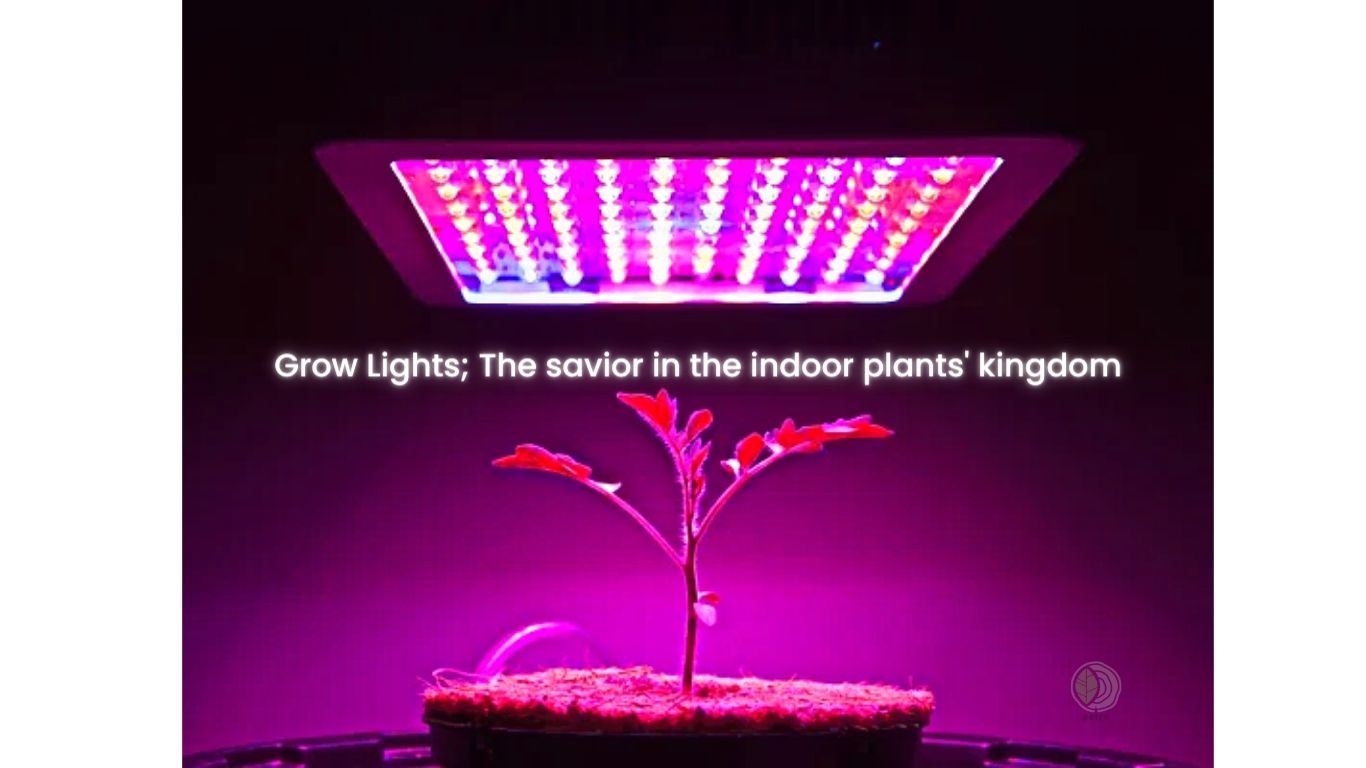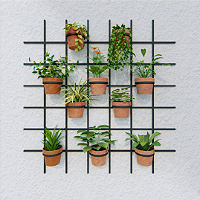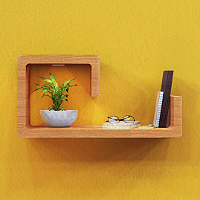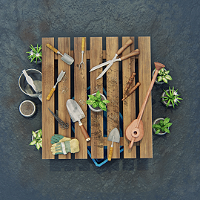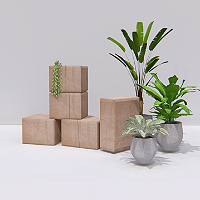All life on earth depends on energy from the sun. Nearly all plant life requires light too develop and flourish. When it comes to creating a true indoor jungle in the 21st century, the lack of natural light is the largest obstacle people face.
Technology is there to help whenever humankind encounters a problem. Just like an artificial but fully functional heart, we can now provide our houseplants with a modest amount of sunlight. Because of recent technological advancements, a new and improved form of artificial lighting—grow light—has become available, offering newfound hope to indoor plant life.
Grow lights allow us to cultivate various indoor plants, regardless of the season or available sunlight. They use a specific ratio of wavelengths, mostly in the red and blue spectrums, which are ideal for helping plants photosynthesize.
Their effectiveness depends on:
- The intensity of the lamp (known as the photosynthetic photon flux density or PPFD);
- The wavelength (the spectrum of light, known as photosynthetically active radiation or PAR)
Types of grow light:
- Incandescent Light,
- Fluorescent Light,
- LED Plant Grow Light
- High-Intensity Discharge (HID)
What is the Ideal Grow Light Spectrum for Plants?
Grow light spectrum refers to the electromagnetic wavelengths of light produced by a light source to promote plant growth. For photosynthesis, plants use light in the PAR (photosynthetic active radiation) region of wavelengths (400nm-700nm) measured in nanometers (nm).
Typically, chlorophyll, the molecule in plants responsible for converting light energy into chemical energy, absorbs most light in blue and red-light spectrums for photosynthesis. Both red and blue light are found in the peaks of the PAR range.
The above chart shows the PAR range – the spectrum of light that plants use for photosynthesis.
Red radiation (around 700nm) is considered the most efficient at driving photosynthesis – especially in the flowering stage for biomass growth.
Blue light is essential for both the vegetative and flowering stages of plant growth, but mainly for establishing vegetative and structural growth.
Source: www.ncbi.nlm.nih.gov/pmc/articles/PMC3949401
https://doi.org/10.1159/000489030
www.ncbi.nlm.nih.gov/pmc/articles/PMC6448094
The Ideal Grow Light Spectrum for Plants
- Violet-blue light in the (400-520) nanometer range encourages chlorophyll absorption, photosynthesis, and growth.
- Red light in the (610-720) nanometer spectrum range promotes flowering and budding.
The right spectrum of light for photosynthesis, which is essential for plant growth, must be provided bygrowthw lights. This is where LED lighting is useful. The majority of LED grow lights provide both forms of color spectrum lighting, allowing you to reap all of the benefits.
Spectrum for Photosynthesis, Growth, and Yield
Other light spectrums, such as greens/yellows/oranges, are less effective for photosynthesis due to the amount of chlorophyll b, which is absorbed mostly by blue light, and chlorophyll a, which is absorbed primarily by red and blue light.
Blue light is vital for plant growth because it helps plants produce healthier stems, enhanced density, and established roots during the early vegetative growth phases. Growth is thus accelerated by greater red-light absorption, resulting in longer stems, more leaf and fruit/flowering, and so forth. Red light is the most important factor in plant development and, thus, size.
Finally, yield is determined by a combination of light spectrums and is often quite distinctive to producers, especially those who grow multiple types of the same crop.
Lighting Hours
How long to keep grow lights on plants depends on several factors.
- As a general rule of thumb, most vegetables and flowering plants need 12 to 16 hours of light per day, with flowering plants at the top end of that range.
- Plan on giving most plants at least 8 hours of darkness per day.
- But remember that different types of plants may need different amounts of light.
Darkness is very important for the plant growth cycle. During the day, sunlight helps plants produce energy through photosynthesis. At night, however, plants break this energy down for growth and flowering in a process called “respiration”.
Source: www.lampsplus.com/ideas-and-advice/grow-lights-for-indoor-plants-_2d00_-getting-started.
Why do different grow lights need to be set at different heights?
Placing the lights at the correct distance from your plants lets them absorb the light they need without burning the plants. The ideal fluorescent T5 grow light distance from plants is 3 to 12 inches, advises the Old Farmer’s Almanac. LED grow light height above plants should be 12 to 24 inches above your plants and HID lights should be placed 24 to 60 inches above the top of your plant.
Source: The University of Missouri Extension.
HID Grow Lights
When using HID grow lights, keep them at least 12″ (30cm) away from your plants at all periods.
HIDs need to be hung above your plants at a good height because of the heat they generate, so if you’re using his it’s important to have a tall growing space:
- (400w HID Grow Lights) 12″-19″ away from plants
- (600w HID Grow Lights) 14″-25″ away from plants
- (1000w HID Grow Lights) 16-31″ away from plants
LED Grow Lights
LEDs don’t generate lots of heat, but you’d be surprised by how high you have to hang them above your plants. Supplemental LED lights, used to grow little patches of wheatgrass, herbs, and spices (15w-90w), need to be at least 15″ away from your plants.
For higher-wattage lights it’s even further:
- (240-400w LED Grow Lights) 16-30” away from plants
- (450-550w LED Grow Lights) 20-30” away from plants
- (600-850w LED Grow Lights) 24-26 away from plants
- (900w+ LED Grow Lights) 26-42” away from plants
Note: while HIDs need to be hung at a consistent distance throughout the plant’s growth cycle, LEDs will need to be moved closer to the plant during the flowering stage.
Fluorescent Grow Lights
Due to their compact size, CFL bulbs can generate considerable heat over an extended period, whereas a longer 54W 2ft T5 grow light will generate less heat because it can dissipate along its tube. In addition, the more bulbs you use, the more heat you will produce, which can be hazardous if they are hung too close to the plants.
In general, you’ll want to hang your light no more than 12″ away from your plants.
Source: www.growace.com/blogs/learning-center/how-high-should-your-grow-lights-be-above-your-plants.
How to Use Grow Lights
Succeeding with grow lights will be a process of trial and error. So have fun, experiment, and don’t get discouraged too quickly.
Here are a few steps to help you succeed:
- Choose your bulb wisely.
- Put the lights close to the plantsbased onf watt and height.
- Use the proper timer.
- Don’t forget the water.
- Maintain the routine according to plants’ reactions.
It is the year 2022, and we strongly recommend that you already have your very own slice of sunshine (grow lights) inside your home. To live a better life, we need plants, andforr plants to thrive, they need a few basic things. So why wouldn’t we give them our absolute best?


